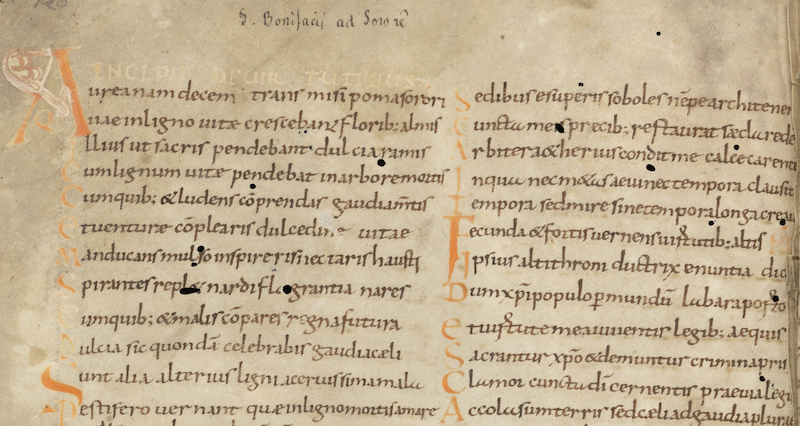The Devonian missionary and bishop, Boniface (ca. 675-754), was the leading figure in the English mission to Frisia and Germania during the 8th century. Many texts have been ascribed to Boniface in medieval manuscripts, some of them undoubtedly genuine and others more spurious. His best-known works are his letters to friends and colleagues across England and continental Western Europe. Less well-known is the riddle collection that is attributed to him, which appears—in whole or in part—in at least 10 manuscripts produced on the Continent. Although only one early medieval scribe attributes them to Boniface (British Library, Royal MS 15 B XIX, fol. 204r), their authorship is universally accepted.
Whereas other riddle collections focus on the natural world and the world of objects, Boniface’s riddles concentrate exclusively on the supernatural world. The first ten riddles depict ten virtues, and the second ten depict ten vices. The solutions are included in the riddles using an acrostic on the first letter of most, but not all, lines. In many manuscripts, the riddles include a prologue and epilogue to the virtues, but none are given for the vices.

All the riddles focus on the same theme—the role of the virtues and vices in helping humans to secure an eternal home in heaven or hell. This focus gives the riddles a distinctly didactic feel, given that their function is quite obviously to instruct the reader on how to reach heaven. The riddles also use a similar vocabulary. For example, because all the Latin words for the virtues and vices are grammatically feminine, Boniface refers to them as virgines (“maidens”). So, Humility is described as a lectissima virgo (“most excellent maiden”) and Virginity as the clarissima virgo ("brightest maiden"), while Negligence is the stultissima virgo (“stupidest maiden”) and Vainglory is a virgo maligna (“evil maiden”). In the poems, these women generally speak in the first person, although there are a handful of occasions where an unnamed speaker describes them instead. The riddles also show the influence of Aldhelm’s riddles and other works, such as his De virginitate (“On virginity”), in their word choice.
Boniface’s riddles are quite clearly different from most other riddles in the tradition. In fact, you could argue that they aren’t really riddles at all, given that their solutions are recorded in acrostics. Nevertheless, the riddles employ some tropes and motifs that are common to other riddles, such as virginity, birth, and desultory first-person narratives. Several of the riddles contain apparent paradoxes, usually related to heaven and hell. For example, Humility tells us in Riddle 9, Ima solo quantum, tantum dio proxima caelo (“As much as I am in the lowest place, I am also nearest to divine heaven”).
Editions
- Dümmler, Ernst, ed. Poetae Latini aevi Carolini, Volume 1. Berlin: MGH/Weidmann, 1881, pages 3-15. Available online here.
- Giles, John Allen, ed. Bonifacii opera, Volume II. London: D. Nutt, 1844, pages 109-115. Available online here.
- Glorie, Fr., ed. (with a German translation by Karl J. Minst). Variae collectiones aenigmatum Merovingicae aetatis. Corpus Christianorum, Series Latina 133. Turnhout: Brepols, 1968, pages 273-343.
- Orchard, Andy, ed. and trans. The Old English and Anglo-Latin Riddle Tradition. Dumbarton Oaks Medieval Library. Cambridge, MA: Harvard University Press, 2021, pages 182-221; and A Commentary on “he Old English and Anglo-Latin Riddle Tradition. Cambridge, MA: Harvard University Press, 2021, pages 230-25.
Studies of Boniface's Riddles
- Cavell, Megan, and Jennifer Neville. "Aldhelm's Fandom: The Humble Virtues of Boniface's Riddles." Review of English Studies, vol. to be assigned (2023), page range to be assigned. Available online here.
- Clark. Amy W. "Familiar Distances: Beating the Bounds of Early English Identity." Diss. University of California, Berkeley, 2020 (esp. chapter 2).
- Finch, Chauncey E. “The Text of the Aenigmata of Boniface in Codex Reg. Lat. 1553.” Manuscripta, vol. 6 (1962), pages 23-8.
- Thornbury, Emily V. Becoming a Poet in Anglo-Saxon England. Cambridge: University of Cambridge Press, 2014 (esp. chapter 5).
- Thornbury, Emily V. “Boniface as Poet and Teacher.” In A Companion to Boniface, edited by Michel Aaij and Shannon Godlove. Leiden: Brill, 2020. 99-122.
Digitised Manuscripts
- Cambridge, Cambridge University Library, MS Gg.5.35. Folios 382r-388v. Available here.
- Einsiedeln, Stiftsbibliothek, Codex 302 (450). Pages 126-131. Available here.
- London, British Library, Royal MS 15 B XIX. Folios 204r-205v. Available here.
- Paris, Bibliothèque nationale de France. Latin 13046. Folio 118v. Available here.
- Vatican City, Biblioteca Apostolica Vaticana, Reg. Lat. 1553. Folios 1r-8v. Available here.
- Vatican City, Biblioteca Apostolica Vaticana, Pal. Lat. 591. Folios 131r-137v. Available here.
View all posts for Boniface's Riddles
<< Back to Collections overview
EXETER RIDDLE 51 IN ITALIAN / IN ITALIANO
EXETER RIDDLE 25 IN ITALIAN / IN ITALIANO
EXETER RIDDLE 7 IN ITALIAN / IN ITALIANO
EXETER RIDDLE 11 IN SPANISH / EN ESPAÑOL
2024 (4)
2023 (4)
2022 (251)
2021 (185)
2020 (76)
2019 (9)
2018 (19)
2017 (33)
» DEC 2017 (6)
» NOV 2017 (1)
» OCT 2017 (5)
» SEP 2017 (2)
» AUG 2017 (3)
» JUL 2017 (1)
» JUN 2017 (1)
» MAY 2017 (3)
» APR 2017 (3)
» MAR 2017 (1)
» FEB 2017 (3)
» JAN 2017 (4)
2016 (14)
2015 (32)
2014 (31)
2013 (33)
BONIFACE'S RIDDLES (22)
EUSEBIUS'S RIDDLES (60)
SYMPHOSIUS'S RIDDLES (101)
TATWINE'S RIDDLES (42)
THE BERN RIDDLES (128)
THE EXETER BOOK RIDDLES (184)
THE EXETER BOOK RIDDLES IN BOSNIAN, CROATIAN, MONTENEGRIN AND SERBIAN (4)
THE EXETER BOOK RIDDLES IN INDONESIAN (2)
THE EXETER BOOK RIDDLES IN ITALIAN (4)
THE EXETER BOOK RIDDLES IN SPANISH (23)
THE LORSCH RIDDLES (24)